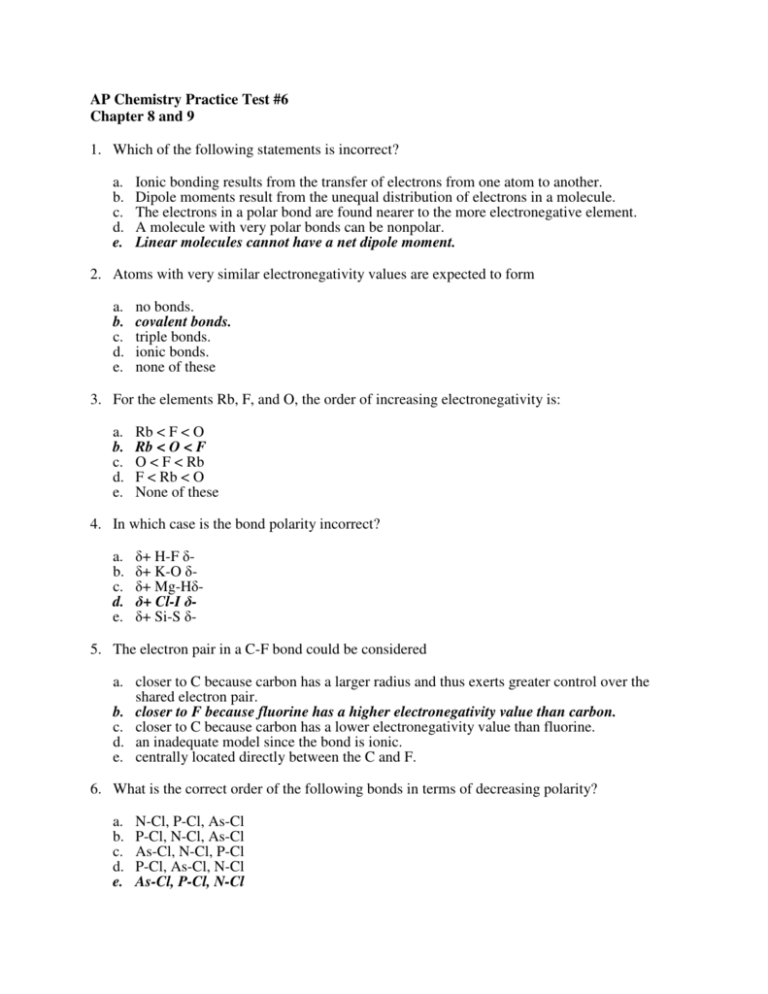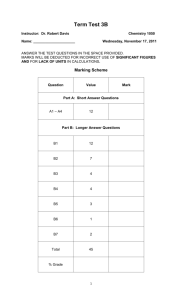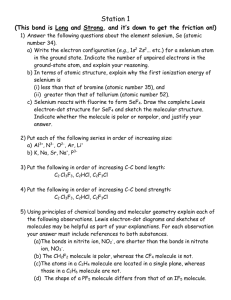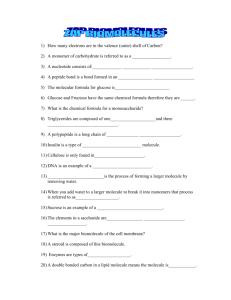AP Chemistry Practice Test #6 Chapter 8 and 9
advertisement

AP Chemistry Practice Test #6 Chapter 8 and 9 1. Which of the following statements is incorrect? a. b. c. d. e. Ionic bonding results from the transfer of electrons from one atom to another. Dipole moments result from the unequal distribution of electrons in a molecule. The electrons in a polar bond are found nearer to the more electronegative element. A molecule with very polar bonds can be nonpolar. Linear molecules cannot have a net dipole moment. 2. Atoms with very similar electronegativity values are expected to form a. b. c. d. e. no bonds. covalent bonds. triple bonds. ionic bonds. none of these 3. For the elements Rb, F, and O, the order of increasing electronegativity is: a. b. c. d. e. Rb < F < O Rb < O < F O < F < Rb F < Rb < O None of these 4. In which case is the bond polarity incorrect? a. b. c. d. e. δ+ H-F δδ+ K-O δδ+ Mg-Hδδ+ Cl-I δδ+ Si-S δ- 5. The electron pair in a C-F bond could be considered a. closer to C because carbon has a larger radius and thus exerts greater control over the shared electron pair. b. closer to F because fluorine has a higher electronegativity value than carbon. c. closer to C because carbon has a lower electronegativity value than fluorine. d. an inadequate model since the bond is ionic. e. centrally located directly between the C and F. 6. What is the correct order of the following bonds in terms of decreasing polarity? a. b. c. d. e. N-Cl, P-Cl, As-Cl P-Cl, N-Cl, As-Cl As-Cl, N-Cl, P-Cl P-Cl, As-Cl, N-Cl As-Cl, P-Cl, N-Cl 7. How many of the following molecules possess dipole moments? BH3, CH4, PCl5, H2O, H2 a. b. c. d. e. 1 2 3 4 5 8. Which of the following molecules (or ions) has a dipole moment? a. CO2 b. CO32c. NH4+ d. PF3 e. two of them do 9. Choose the statement that best describes the PbCl4 molecule in the gas phase. a. b. c. d. e. The bond angles are all about 109o. The molecule is polar. The molecule has a dipole moment. The bonds are nonpolar. a, b, and c 10. When electrons in a molecule are not found between a pair of atoms but move throughout the molecule, this is called a. b. c. d. e. ionic bonding. covalent bonding. polar covalent bonding. delocalization of the electrons. a dipole moment. 11. Choose the molecule with the strongest bond. a. b. c. d. e. HF HCl HBr HI All are equal. 12. As the number of bonds between two carbon atoms increases, which one of the following decreases? a. b. c. d. e. number of electrons between the carbon atoms bond energy bond length all of these none of these 13. Using the following bond energies Bond Bond Energy (kJ/mol) C≡C 839 C-H 413 O=O 495 C=O 799 O-H 467 estimate the heat of combustion for one mole of acetylene: C2H2(g) + (5/2)O2(g) → 2CO2(g) + H2O(g) a. b. c. d. e. 1228 kJ -1228 kJ -447 kJ +447 kJ +365 kJ 14. Which of the following species is best described by drawing resonance structures? a. b. c. d. e. PH3 NH4+ O3 SO3HCN Use the following to answer questions 15-17: Using the following electronegativity values C 2.5 C 3.2 H 2.2 N 3.0 O 3.4 select from the following group the molecule that fits the given statement: a) CH3CHO b)_ CO2 c) CH3Cl d) C2H6 e) none 15. This molecule contains a carbon atom with trigonal planar geometry. (a) 16. This molecule is the most polar. (a) 17. This molecule shows the smallest number of lone pairs in its Lewis structure. (d) 18. As indicated by Lewis structures, which of the following would probably not exist as a stable molecule? a. CH3OH b. CH2O c. CH3O d. C2H2 e. C3H4 19. Select the best Lewis structure for acetone, CH3COCH3. (b) a. H H H C C O C H H H H H O H C C C H H b. H H c. H C C O H C H H H H H H C C O C H H H H H H e. H C C C O H H d. 20. Which of the following is the correct order for molecules from most to least polar? a. b. c. d. e. CH4 > CF2Cl2 > CF2H2 > CCl4 > CCl2H2 CH4 > CF2H2 > CF2Cl2 > CCl4 > CCl2H2 CF2Cl2 > CF2H2 > CCl2H2 > CH4 = CCl4 CF2H2 > CCl2H2 > CF2Cl2 > CH4 = CCl4 CF2Cl2 > CF2H2 > CCl4 > CCl2H2 > CH4 21. Of the following, which molecule has the largest bond angle? a. b. c. d. e. O3 OF2 HCN H2O More than one of the above have equally large bond angles. 22. According to the VSEPR model, the arrangement of electron pairs around NH3 and CH4 are a. different because in each case there are a different number of atoms around the central atom. b. different because in each case there are a different number of electron pairs around the central atom. c. the same because both nitrogen and carbon are both in the second period. d. the same because in each case there are the same number of electron pairs around the central atom. e. different or the same, depending on the conditions leading to maximum repulsion. 23. Which of the following atoms cannot exceed the octet rule in a molecule? a. b. c. d. e. N S P I All of the atoms (a-d) can exceed the octet rule. 24. In the cyanide ion (CN-), the nitrogen has a formal charge of a. b. c. d. e. -2 -1 0 2 2 25. How many of the following molecules – SF2, SF4, SF6, SiO2- are polar? a. b. c. d. e. 0 1 2 3 4 26. How many resonance structures can be drawn for the molecule O3? a. b. c. d. e. 1 2 3 4 5 27. Choose the electron dot formula that most accurately describes the bonding in CS2. (Hint: Consider formal charges.) a) S C S C S S b) S C S S C S S C S c) d) e) 28. In the Lewis structure for elemental nitrogen there is (are) a. b. c. d. e. a single bond between the nitrogens. a double bond between the nitrogens. a triple bond between the nitrogens. three unpaired electrons. none of the above Use the following to answer questions 29-31: Consider the compound crotonaldehyde, whose skeleton is H H H H H C1 C 2 C 3 C 4 O H 29. How many electrons must be shown in the Lewis structure of this molecule? a. b. c. d. e. 12 18 24 28 32 30. How many nonbonding electrons appear in the Lewis structure of this molecule? a. b. c. d. e. 2 4 6 8 10 31. Which carbon in this molecule has tetrahedral bonding? a. 1 b. 2 c. 3 d. 4 e. all 32. The Lewis structure for H3BO3 is a) H O O B H O H b) H O B O H O H O H O H O H c) H O B O d) H O H B O H e) H O B O H Use the following to answer questions 33-34: Consider the following molecules. I. BF3 II. CHBr3 (C is the central atom) III. Br2 IV. XeCl2 V. CO VI. SF4 Select the molecule(s) that fit the given statement. 33. These molecules violate the octet rule. a. b. c. d. e. I, II, IV I, III, IV, VI III, V, VI I, IV, VI I, II, IV, VI 34. These molecules have a zero net dipole moment. a. b. c. d. e. III, V I, III, IV II, IV, V I, III, IV, VI none of them 35. The geometry of AsCl5 is a. b. c. d. e. trigonal bipyramidal square pyramidal distorted tetrahedral octahedral none of these 36. How many of the following molecules or ions are linear? NH3 NH4+ HCN CO2 NO2 a. b. c. d. e. 0 1 2 3 4 37. The bond angles about the carbon atoms in the formaldehyde molecule, H2C=O, are about: a. b. c. d. e. 120o 60o 109o 180o 90o 38. Which of the following species has a trigonal bypyramid structure? a. b. c. d. e. NH3 IF5 I3PCl5 none of these 39. Which ion is planar? a. b. c. d. e. NH4+ CO32SO32ClO3all are planar 40. In the molecule XeF2, how many pairs of electrons surround Xe and what is the molecular geometry? a. b. c. d. e. 4, bent 4, pyramidal 5, linear 5, bent 6, linear 41. How many of the following molecules have all of their atoms in the same plane> H2C=CH2 F2O H2CO NH3 CO2 BeCl2 a. b. c. d. e. 3 4 5 6 7 Use the following to answer questions 42-45: For each of the following compounds: a) draw the Lewis structure b) give the shape of the molecule c) indicate the polarity of the molecule 42. AlF3 trigonal planar, nonpolar 43. NH3 trigonal pyramidal; polar 44. ICl4- square planar; nonpolar 45. CBrI3 tetrahedral; polar 46. If a compound has a number of individual dipoles, then I. it is polar overall II. there is an electronegativity difference between the bonded atoms III. it is ionic IV. it doesn’t have resonance a. b. c. d. e. II only II, IV I, II, IV I, III All of the above statements are correct. 47. The hybridization of the phosphorus atom in the cation PH2+ is: a. b. c. d. e. sp2 sp3 dsp sp none of these 48. Which of the following statements is (are) incorrect? I. II. III. IV. a. b. c. d. e. The hybridization of boron in BF3 is sp2. The molecule XeF4 is nonpolar. The bond order of N2 is three. The molecule HCN has two pi bonds and two sigma bonds. All four statements are correct. II is incorrect. I and IV are incorrect. II and III are incorrect. II, III, and IV are incorrect. 49. The hybridization of the central atom in I3- is: a. b. c. d. e. sp sp2 sp3 dsp3 d2sp3 50. Which of the following does not contain at least one pi bond? a. b. c. d. e. H2CO CO2 C2H4 C3H8 All of the aboe (a-d) contain at least one pi bond. 51. Consider the following Lewis structure H H O H H C C C C 3 2 1 H H Which statement about the molecule is false? a. There are 10 sigma and 2 pi bonds. b. C-2 is sp2 hybridized with bond angles of 120o. c. Oxygen is sp3 hybridized. d. This molecule contains 28 valence electrons. e. There are some H-C-H bond angles of about 109o in the molecule. 52. Consider the following Lewis structure: H H C H O H C 1 H a. b. c. d. e. O sp3 sp sp sp2 sp C C C 2 3 4 H C-1 sp3 sp3 sp2 sp3 sp3 C-2 sp sp sp sp2 sp2 C-4 sp2 sp sp2 sp3 sp 53. The hybridization of Br in BrF3 is a. b. c. d. e. sp sp2 sp3 dsp3 d2sp3 N H 54. The hybridization of the central atom Al, in AlBr3 is a. b. c. d. e. sp sp2 sp3 dsp3 d2sp3 Use the following to answer questions 55-57: Tetracyanoethylene has the skeleton shown below: From its Lewis structure determine the following: 55. How many sigma and pi bonds are in the molecule? a. 5 sigma and 9 pi b. 6 sigma and 8 pi c. 9 sigma and 7 pi d. 9 sigma and 9 pi e. 5 sigma and 8 pi 56. How many of the atoms are sp2 hybridized? a. b. c. d. e. 2 4 6 8 10 57. How many of the atoms of sp hybridized? a. b. c. d. e. 2 4 6 8 10








